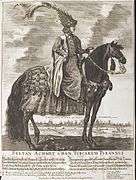Handan Sultan
| Handan Sultan خندان سلطان | |
|---|---|
|
Valide-i iffet-penah Mahd-i Ulya Sultanat Valide-i macide | |
|
The türbe of Handan is located next to that of Mehmed III in the courtyard of Hagia Sophia | |
| Valide Sultan of the Ottoman Empire | |
| Tenure | 22 December 1603 – 12 November 1605 |
| Predecessor | Safiye Sultan |
| Successor | Halime Sultan |
| Born |
Helen[1] 1574 |
| Died |
12 November 1605 (aged 31) Istanbul, Ottoman Empire |
| Burial | Tomb of Ottoman Sultan Mehmed III |
| Spouse | Mehmed III, Ottoman Sultan |
| Issue |
Ahmed I Esra Sultan |
| Religion |
Islam previously Orthodox Christian |
Handan Sultan (Ottoman Turkish: خندان سلطان; c. 1574[2] – 12 November 1605;[3] Handan meaning "Joyful") was the Ottoman Valide Sultan as mother of the Ottoman Sultan Ahmed I from 22 December 1603 until 12 November 1605 although according to some sources including Yılmaz Öztuna, she died 27 November 1605.[4]
Origin
According to A.D. Alderson, her origin is unknown.[5] Some sources claim that she was ethnically Greek, originally named Helena.[1][6]
Life
She was one of the ladies of Mehmed III when he served as the governor of Manisa and gave birth to Ahmed I in 1590.
Prior to Ahmed's accession to the throne, she has not enjoyed any kind of power and wasn't Mehmed III's Haseki Sultan (chief wife). She might have been completely overshadowed by Safiye Sultan, Ahmed I's paternal grandmother who continued to manage the harem.
Apparently, Handan couldn't surpass her mother-in-law Safiye Sultan, or her fellow consort Halime Sultan, and later her daughter-in-law Kösem Sultan, and was not an actress of the Sultanate of Women even when she became the Valide Sultan and acted as the co-regent. During the first two years of the reign of Sultan Ahmed I, she was the Valide Sultan, being his mother, and wielded some kind of power, and tried to manage the government for two years, but as some chronicles say, she was totally inexperienced about her role.
The contemporary historian Ibrahim Pecevi questioned her wisdom. Leslie Peirce points out that Ahmed tended to disregard her advice but believed that she ruled the Ottoman Empire behind the scenes, acting as the advisor of her young son.[7] While respecting the tradition that a mother's right is God's right, he ingeniously circumvented her will. She did not manage to receive either influence or economic funds as had the two previous Valide Sultans, this was probably due in a large measure because of the fact that she wasn't Mehmed III's Haseki Sultan and was a simple slave before she became the Valide Sultan.
Her salary was only 1000 aspers/a day even though she acted as the Valide Sultan during the first two years of the reign of her son Sultan Ahmed I while his grandmother Safiye was receiving 3000 akçes during the same period. At the opposite, when Mustafa I ascended the throne in 1617, his mother Halime received 3,000 aspers/a day although her mother-in-law Safiye was still alive. Handan was well liked because she didn't interfered into politics the way that Safiye did, and was known for her kindness, wisdom and mercy and for her mild character.
Since her son became the Sultan, Handan dismissed the most of the harem people and the palace servants who were close and connected to Safiye Sultan.[8]
Death
Handan died on 12 November 1605 at Topkapi Palace at a young age (30-31) during reign of her son Ahmed and the reason of her death is a matter of controversy. She probably died as a result of a severe stomach upset. They were some speculations that she was possibly poisoned either by Safiye or Kösem or that she committed a suicide or died because of her worry about her son who was facing the Jelali revolts.
Handan's early death and the exile of Safiye to the Old Palace is one of the reasons that permitted the rise of Kösem who apparently couldn't rise in the Harem as long as Valide Handan was alive. She was buried near Mehmet III's tomb at the courtyard of Hagia Sophia.
In popular culture
In the 2015 TV series Muhteşem Yüzyıl: Kösem, Handan Sultan is portrayed by Turkish actress Tülin Özen.
-

Her husband, Mehmed III.
-

Sultanahmed Mosque was built during the regency of Handan's son, Ahmed I.
-

Her son, Ahmed I.
See also
- Ottoman Empire
- Ottoman dynasty
- Ottoman family tree
- List of Valide Sultans
- List of sultans of the Ottoman Empire
- Line of succession to the Ottoman throne
- Ottoman Emperors family tree (simplified)
- List of consorts of the Ottoman Sultans
Further reading
- Peirce, Leslie P., The Imperial Harem: Women and Sovereignty in the Ottoman Empire, Oxford University Press, 1993, ISBN 0-19-508677-5 (paperback).
References
- 1 2 Meram, Ali Kemal (1977). Padişah Anaları: Resimli Belgesel Tarih Romanı (in Turkish). İstanbul: Öz Yayınları. p. 244. OCLC 8825122.
- ↑ Öztuna, Yılmaz (2005). Devletler ve Hanedanlar. Ankara, TURKEY: Kültür ve Turizm Bakanlığı Yayınları. p. 176. ISBN 9789751704696.
- ↑ Sakaoğlu, Necdet (2008). Bu Mülkün Kadın Sultanları (Vâlide Sultanlar, Hâtunlar, Hasekiler, Kadınefendiler, Sultanefendiler). Oğlak Yayıncılık. p. 219. ISBN 9789753297172.
- ↑ Öztuna, Yılmaz (2005). Devletler ve Hanedanlar. Ankara: Kültür ve Turizm Bakanlığı Yayınları. p. 176. ISBN 9789751707918.
- ↑ Alderson, A.D., The Structure of the Ottoman Dynasty, Oxford university press, 1956, p.83
- ↑ İnal, Günseli; Özdem, Filiz; Işın, Mary; Semiramis Arşivi (2005). Semiramis: Sultan'ın Gözünden Şenlik [Festival Through a Sultan's Eyes] (in Turkish). İstanbul: Yapı Kredi Yayınları. p. 27. ISBN 9789750809286.
- ↑ Peirce, Leslie Penn (1993). The Imperial Harem : Women and Sovereignty in the Ottoman Empire. Studies in Middle Eastern history. New York: Oxford University Press. ISBN 978-0-19-508677-5.
- ↑ Günhan BÖREKÇİ A Dynasty at the Threshold of Extinction: Mehmed III, Ahmed I, Mustafa I and the 17th-Century Ottoman Political Crisis P. 90
| Ottoman royalty | ||
|---|---|---|
| Preceded by Safiye Sultan |
Valide Sultan 22 December 1603 – 26 November 1605 |
Succeeded by Halime Sultan |